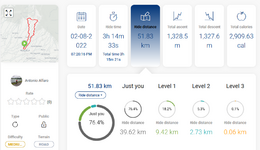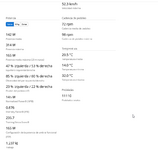It has taken me some time to understand the data you provided about the 43.09Km run on flat ground but
based on 623 Wh composition, 1.9 hours of total duration of the route, your contribution of 142Wh and the Ebike 481Wh, come to be in term of average power (during the entire route) :
74.4 W from you, and
253.1W from the eBike.
We can not say (never ) that the average of 74.4W is equivalent to the FTP. No, it just means that on that ride you held 74W for whatever reason, but it doesn't mean that's all you can hold. On this ride you just let the ebike do 77% of the effort.
To really determine our FTP, we must make a measurement following a correct procedure and with the correct equipment (there is a lot of literature and applications about it). I recommend to do such a test.
Let me give an example of a real route of another cyclist and let's see the differences. General data:
Distance 51.83Km, Time 3.23hrs, Mountain pass 1328 meters of ascent, FTP (real measured) of the cyclist is 165W, mass of the cyclist 56Kg, W/Kg near to 3.
The Mahle app was used for battery consumption recording data only, and the Garmin Connect app in conjunction with the Garmin Edge 820 device and PowerTap pedals with power measurement to measure the power delivered by the rider.
We observed that the cyclist delivered an average of 142W from himself and required only an average of 24W from the Ebike. In other words, 15% of the power to carry out this route was provided by the Ebike and 85% was provided by the cyclist. Also note that the sustained average on this trip is consistent with his 165W FTP.
It makes me think that in your case, we can't say that your FTP is 80W or something like that, until a true measurement is done following standard procedures. Never with an eBike.
It is not an issue of age, nor of illness, it is that 80W of FTP seems to be too low, Iam such that you can delivery and sustain much more power. Lastly, I want to tell you that the cyclist in the example I just mentioned has some peculiarities: he is 68 years old and he is a cancer survivor since 10 years.


